Performance Retrospective: AMD’s Radeon HD 7970M
by Jarred Walton on June 21, 2013 5:25 PM ESTEnthusiast/Ultra 1920x1080 Gaming Performance
Last up on our gaming tests is our punishing “Enthusiast” setting (typically maximum detail, 4xAA or SSAA, 1920x1080 resolution). So far all of the high-end mobile GPUs have proven capable of running our gaming suite at more than playable frame rates, but here we’re likely to see a few cases where you’ll need to turn down the settings to stay about 30FPS. Super-Sampling AA (used in Metro and Sleeping Dogs—but not Tomb Raider as we enable TressFX instead) would be the first option I’d turn off, or 4xAA in the other games; you can try FXAA in a pinch if the jaggies bother you too much. The jump between “High” and “Very High/Ultra/Ultimate/Extreme” is also relatively small in terms of image quality, so that would be the other option for improving performance to hit playable frame rates. With that out of the way, here are our final benchmarks.
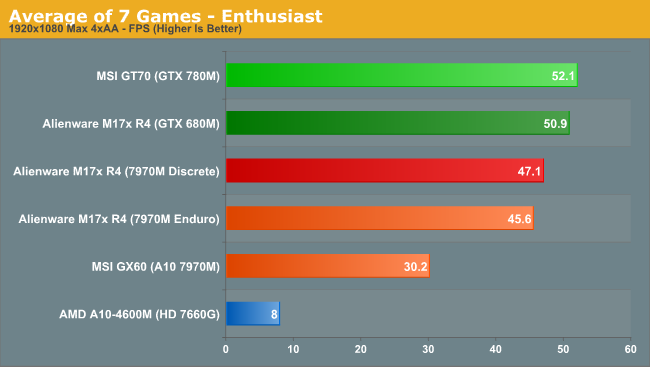
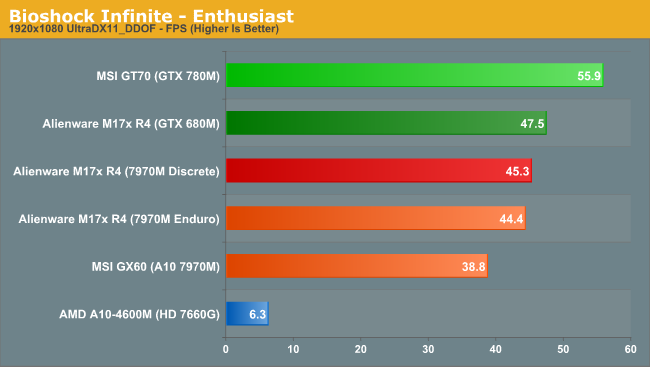
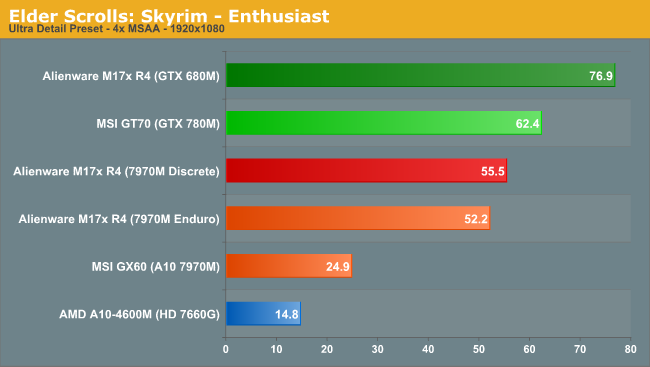
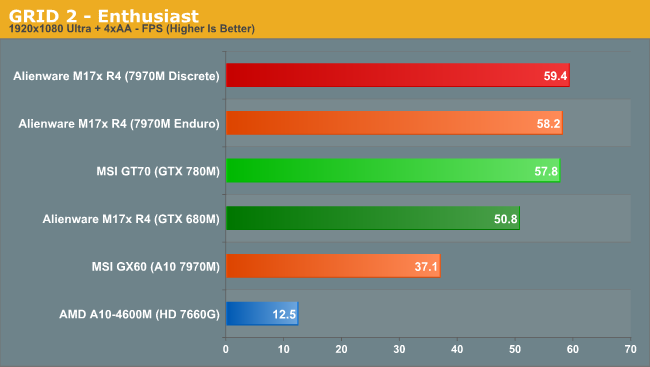
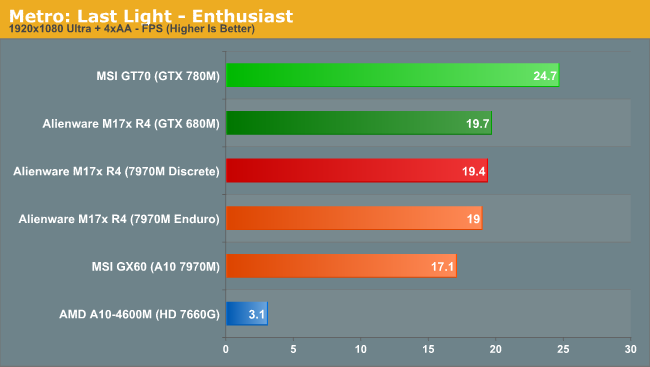
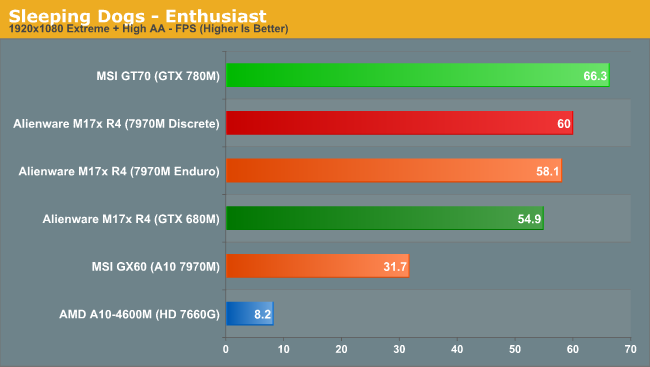
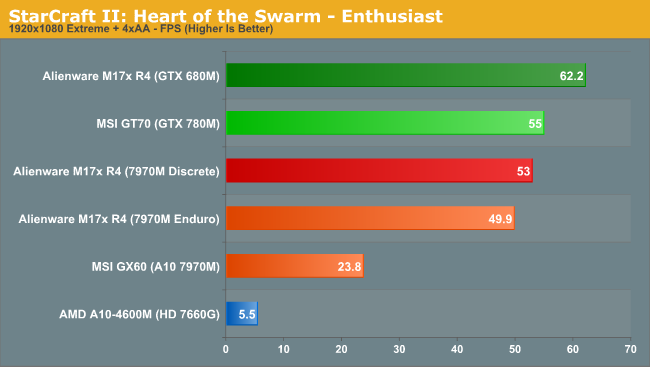
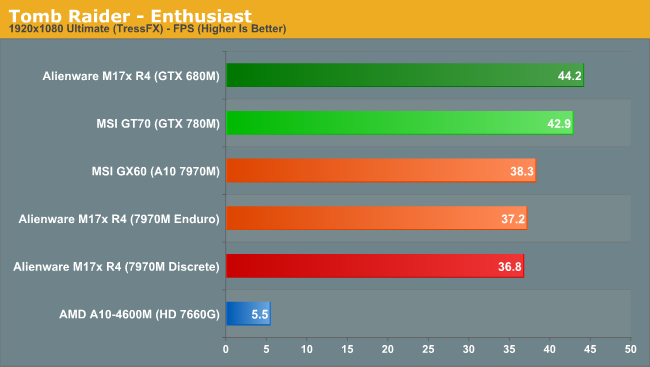
Finally at the Enthusiast level, Enduro on the M17x no longer seems to cause much of a performance penalty. Using discrete mode is still 3% faster on average, but the largest margin of victory is only 6% (in Skyrim and StarCraft II, interestingly, which are the only DX9 games in our current list). Considering most people forking over $2000+ for a high-end gaming notebook are going to be using the GPU more rather than less, it’s good to see that where it matters most in terms of performance is where the Enduro question actually matters least. If you’re not planning on running on battery power much, I’d probably leave the M17x R4 in discrete-only mode and plan on a reboot if you need to go mobile, as in general I’ve found the drivers to be less finicky that way, but your mileage may vary.
Intel Enduro vs. AMD Enduro results get closer one again, with the lead now down to 51% on average. As you can probably guess, the real average lead isn’t nearly so great with the exception of a few games that tend to hit the CPU harder. StarCraft II and Skyrim continue to run over twice as fast on Intel’s CPU with the 7970M, and GRID 2 and Sleeping Dogs are 57% and 83% faster, respectively. Bioshock is only 14% faster this round, which is close enough that you probably don’t need to lose any sleep over the numbers, and Metro likewise is only 11% faster on Intel. Tomb Raider even goes one step further and runs 3% faster on the GX60. That said, out of the seven titles, the AMD platform doesn’t provide smooth frame rates in Skyrim or StarCraft II and barely gets by in Sleeping Dogs; Metro: Last Light ends up being so punishing that none of the notebooks we’ve tested actually break 30FPS average on our Enthusiast settings.
And for those keeping score, the 7970M in the GX60 now outpaces the HD 7660G by nearly 300%. We noted in the introduction that on paper, the 7970M has over four times the performance potential of the 7660G: it has 4.13X the compute performance (1280 shaders at 850MHz compared to 384 shaders at 686MHz) with a dedicated 153.6GB/s of memory bandwidth compared to a shared 25.6GB/s (so at least six times as much bandwidth). On Trinity, we only realize a 3.8x performance increase, but if we compare the discrete M17x 7970M result to 7660G it ends up 5.9X faster, which is just what we’d expect. iGPUs have improved substantially in the last couple of years, but we’re still a long ways away from completely replacing the need for discrete GPUs.
Wrapping up, the NVIDIA vs. 7970M matchup shows that even more than a year after launch, the top mobile GPUs remain evenly matched. The GTX 680M leads by 8% overall, with a large win in Skyrim (39%) and smaller leads in StarCraft II (17%) and Tomb Raider (15%), while the 7970M leads by 14% in GRID 2 and 9% in Sleeping Dogs. The 780M enjoys its largest margin of victory as well, to the tune of 11% faster than 7970M on average. GRID 2 continues to favor AMD just slightly, but everywhere else the 780M beats the 7970M. Thermal throttling is still clearly a problem on the GT70 notebook, and we'll have to wait for an updated system before we can really say how 780M performs.










58 Comments
View All Comments
Aegrum - Friday, June 21, 2013 - link
Great article - I'm really happy to see some benches from these behemoth systems.I will say, though, comparing a $150 APU to a $400 CPU isn't exactly a fair assessment. I'd rather see the GX60 compared to a system in its price range, something with a GTX770m or GTX765m on board, like an MSI GE60 or Sager NP8230.
JarredWalton - Friday, June 21, 2013 - link
See concluding comments on pricing. I know it's not "fair", but however you slice it the MSI GX60 isn't delivering on all fronts as a gaming notebook -- unless games like StarCraft II and Skyrim simply don't matter?Samus - Saturday, June 22, 2013 - link
AMD driver issues? Shocking.huaxshin - Saturday, June 22, 2013 - link
Try to be more precise Jarred:Its not the notebook that isn`t delivering, its the 4600M APU.
JarredWalton - Saturday, June 22, 2013 - link
Let's see...MSI has performance issues on their Dragon laptop. This AMD system is also from MSI. Could there be a correlation? I would say yes. Trinity isn't blazing fast by any means, but in single-threaded performance it's usually no worse than half the speed of single-threaded Core i7. We're seeing cases where it's much less than that, which suggests drivers, platform, and/or laptop are also a factor. My guess is Enduro requires more CPU performance than discrete-only, and it would potentially dirty some of the cache thus making misses more common and thus reducing performance more on some platforms than others.huaxshin - Saturday, June 22, 2013 - link
Dragon Edition 2 review: Cooling problems > hot temperatures > throttling > CPU performance go down > CPU bottleneck > GPU performance go down > Poor gaming performanceGX60: Good cooling
/end
GX60 saw NO CPU throttling nor high temperatures. Since the high end GPUs require a high end CPU, and A10-4600M score half of the 3610QM in single and 1/4th in Multi Cinebench, you don`t have to be a genious to understand that the APU is just too weak. Heck, even look at the lowest end i5, 3210M and its over 50% better in Multi.
I have seen what you guys are trying to do. You are trying to blame MSI for it. Like they can control the very poor APU performance. They are the only OEM that pair up the high end GPU with AMD APU. The notebook is pretty cheap, but its a gamble: it can outrun the GTX 660M in some games, while its the other way around in other.
Dustin Sklavos - Saturday, June 22, 2013 - link
Are you seriously still here?huaxshin - Saturday, June 22, 2013 - link
Yes because you two cannot answer critique and I am able to see right through your recent reviews.Since the PSU is 180W, the cooling is way overbuilt for the APU since it is the exact same design that house hotter Intel CPUs, I am looking for an answer from one of you two about what caused the 7970M performance in the GX60 to go down when it is not the APU itself.
Jarred blame MSI, which is laughable, since all MSI does is include support through BIOS, make sure the cooling is efficient and make sure the components get all the power.
Drivers? AMD make them
Platform? AMD
Laptop? Please enlight us what exactly is wrong with the laptop. I think I covered pretty much everything
Enduro? Perhaps it can count for -some- of the performance decrease. But not 50% decrease or whatever it is. Once again you two cannot look past the fact that the i7 with 7970M and Enduro does far better than 4600M and 7970M with Enduro. That means, the APU is weak...
JarredWalton - Saturday, June 22, 2013 - link
"They are the only OEM that pair [sic] up the high end GPU with AMD APU." Exactly. Why do you think that is? If MSI is selling a laptop which performs far worse than most would expect, that is their problem. If Dell were to make a notebook and stick in an Atom CPU with a high-end GPU, it's not Intel's fault that Dell made a bad design decision.It's nice of MSI to try selling a less expensive gaming laptop, but they should know as well as anyone whether the APU is sufficient to handle the task at hand. And yet, they started shipping the GX60 and now there's an updated version. I blame AMD plenty for their drivers, but MSI does not get off scott free for creating the design in the first place, especially if it doesn't work well.
I am going to see about simulating performance of the 7970M and A10-4600M on the desktop side, using a 7870 and A10-5800K and then underclocking both to the same level as the MSI GX60 is running at. That will remove Enduro from the equation in the process, and I can almost guarantee that performance will be far better than what we're seeing on the GX60. However, that doesn't mean it's only Enduro -- look at the M17x and how the Enduro penalty tapers off at higher resolutions and settings. That's not happening with GX60. And even under gaming loads the CPU cores are at less than 75%, so there's a whole core sitting idle somewhere.
Is it really just a case of the APU and Enduro using so much CPU computational power than performance falls flat, or is it something else like issues with the firmware and BIOS coming into play? The latest BIOS from MSI for the GX60 improved performance by as much as 10%, so there could be a lot of room left for improvement. Even if the problem is completely with AMD's APU performance, again, go back to point number one: if you sell a system that has a poorly matched CPU and GPU, it is your fault as the system manufacturer, because you put the two together.
As for you and your fanboy rantings, you're not helping anything here. Your comments on the NVIDIA GTX 780M article were worthless, as you tried to absolve both NVIDIA and MSI from responsibility. Well, NVIDIA isn't to blame for MSI's bad QA, certainly. And if it's just a bad sample from MSI, sent to a review site that gets major traffic? Shame on MSI yet again. I actually have an MSI GE40 that's mostly good and doesn't have any real issues other than an outdated industrial design and a crappy LCD, which means yet again that it misses the mark. Who do I blame next time, the LCD manufacturer for daring to sell a low contrast LCD?
vlad42 - Sunday, June 23, 2013 - link
Hey Jarred,I was actual going to recommend simulating the A10-4600m and HD 7970m in discrete mode, but I get you beat me to it.
Also, I would recommend contacting AMD’s driver team and share these results with them. It is quite possible that they are unaware of the performance issues that the HD 7970m has in Enduro mode on sub-1080p resolutions (similar to how they were unaware of the micro stuttering issues with their cards). If you think about it, AMD might simply be assuming that any laptop that would have an HD 7970m would also have at least a 1080p display. Thus, they might only be testing Enduro’s performance at 1080p, which, incidentally, is where you found that the performance difference between Enduro and discrete modes on the Alienware M17x R4 was only about 3%.
You might even want to suggest fixing the Enduro performance problems because the ultra high resolution laptops/displays that are coming out, such as Samsung’s ATIV Book 9 with 3200x1800 display, will likely cause gamers to run games at ¼ the native resolution of the display (in the case of the ATIV Book 9 that would be 1600x900) due to how hard it is for any desktop gpu to drive these kinds of resolutions. While you are in contact with them (assuming you do contact them of course) you could try to get an update regarding the DX 9 rendering fix.